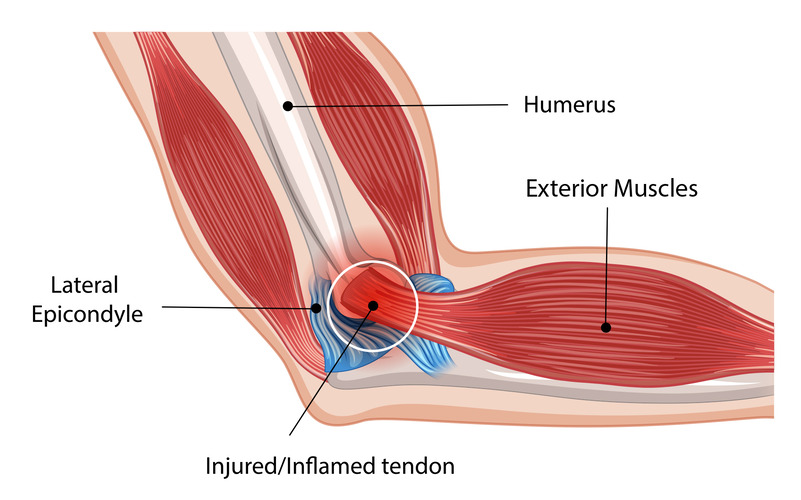About tennis elbow
What is tennis elbow?
The medical term for tennis elbow is lateral epicondylitis, which refers to the onset of pain on the outside aspect of the elbow joint. The humerus bone of the upper arm has bony protrusions on the inside and outside of the elbow called epicondyles.
Tennis elbow develops when the tendon on the outside (lateral) aspect of the elbow becomes irritated or overloaded at its attachment to the bone.
The diagram below shows the area of tendon that is affected by a tennis elbow

Why does it happen?
Tennis elbow is most commonly caused by the overuse of muscles in the forearm that extend the wrist and fingers. Racket sports such as tennis or other activities which involve repeated extension or twisting of the wrist may result in the onset of pain in the outside of the elbow, for example, using a screwdriver or a keyboard. Carrying heavy loads with the elbow straight and the palm facing the floor may also cause pain in the tendon.
Sudden increases in activity or repeated strain can also lead to tendon degeneration such as starting a DIY project, a new job or sporting interest.
What are the symptoms?
The main symptoms are pain and local tenderness on the outside aspect of the elbow. Initially, pain may only occur with sudden forceful activity involving grasping or certain sporting or work activities. As the condition develops, dull aching symptoms may become more constant. There are usually no external symptoms present such as swelling or redness of the skin.
How is the condition treated?
- Initially treatment involves limiting the aggravating activities that stress the tendon
- This may involve adjusting sporting or working activities, for example, making changes to the position of the wrist whilst using a keyboard
- An elbow strap (eipcondylar clasp) may be worn to help unload the tendon
- The use of an ice pack applied to the painful area may help to control pain
- Physiotherapy treatment may also help to reduce symptoms with the use of muscle stretching and strengthening exercises
- Injections/surgery are rarely used.
How do I prevent symptoms re-occurring?
- Symptoms are usually caused by overuse of the forearm extensor muscles, so they can be prevented by modifying activities and keeping muscles and tendons strong.
- Activities involving repeated or prolonged grasping with the elbow straight, carrying heavy objects or high force pulling may lead to the onset of symptoms. It may be necessary to find an alternative method of completing these tasks or stopping them completely
- Continue to perform the exercises provided by your physiotherapist to maintain flexibility and strength in the muscles of the forearm
Information from the British Elbow and Shoulder Society
Rehabilitation exercises for tennis elbow
Eccentric wrist flexion
Eccentric wrist flexion

- Sitting with your hand supported on a table or on your knee
- Start with your wrist extended backwards and apply pressure to the back of your hand with the opposite hand.
- Slowly start to bend your wrist whilst maintaining pressure with the other hand throughout the movement.
- Repeat this 15 times for 3 sets.
- Perform this twice a day.
Wrist flexion stretch
Wrist flexion stretch

- Pull your wrist forwards until you feel a stretch in your wrist.
- You may need to straighten your elbow to increase the stretch in your wrist.
- Hold for 30 seconds and repeat 5 times
- Perform this twice a day
Grip strength exercises
Grip strength exercises

- Using a stress/tennis ball or pair of socks grip as hard as you can for 10 seconds then release
- Repeat this for 3 sets of 10 repetitions twice a day


